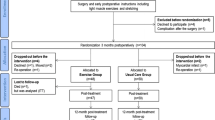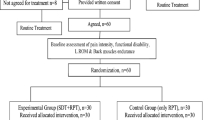Abstract
Purpose
To evaluate the effect of a rehabilitation programme including the management of catastrophising and kinesiophobia on disability, dysfunctional thoughts, pain, and the quality of life in patients after lumbar fusion for degenerative spondylolisthesis and/or lumbar spinal stenosis.
Methods
This was a parallel-group, randomised, superiority-controlled study in which 130 patients were randomly assigned to a programme consisting of exercises and cognitive-behavioural therapy (experimental group, 65 subjects) or exercises alone (control group, 65 subjects). Before treatment (T1), 4 weeks later (post-treatment analysis, T2) and 12 months after the end of treatment (follow-up, T3), all the patients completed a booklet containing the Oswestry Disability Index (ODI, primary outcome), the Tampa Scale for Kinesiophobia, the Pain Catastrophising Scale, a pain Numerical Rating Scale, and the Short-Form Health Survey. A linear mixed model for repeated measures was used for each outcome measure.
Results
The ODI linear mixed model revealed significant main effects of group (F(1,122.8) = 95.78, p < 0.001) and time (F(2,120.1) = 432.02, p < 0.001) in favour of the experimental group. There was a significant group × time interaction effect (F(2,120.1) = 20.37, p < 0.001). The analyses of all of the secondary outcome measures revealed a significant effect of time, group and interaction in favour of the experimental group.
Conclusion
The rehabilitation programme, including the management of catastrophising and kinesiophobia, was superior to the exercise programme in reducing disability, dysfunctional thoughts, and pain, and enhancing the quality of life of patients after lumbar fusion for degenerative spondylolisthesis and/or LSS. The effects lasted for at least 1 year after the intervention ended.

Similar content being viewed by others
References
Kalichman L, Kim HD, Li L, Guermazi A, Berkin V, Hunter DJ (2009) Spondylolysis and spondylolisthesis prevalence and association with low back pain in the adult community-based population. Spine (Phila Pa 1976) 34:199–205
Haig AJ, Tong HC, Yamakawa KSJ, Parres C, Quint DJ, Chiodo A, Miner JA, Phalke VC, Hoff JT, Geisser ME (2006) Predictors of pain and function in persons with spinal stenosis, low back pain, and no back pain. Spine (Phila Pa 1976) 31:2950–2957
Weinstein JN, Lurie JD, Tosteson TD, Zhao W, Blood EA, Tosteson AN, Birkmeyer N, Herkowitz H, Longley M, Lenke L, Emery S, Hu SS (2009) Surgical compared with nonoperative treatment for lumbar degenerative spondylolisthesis. Four-year results in the Spine Patient Outcomes Research Trial (SPORT) randomized and observational cohorts. J Bone Joint Surg Am 91:1295–1304
Kovacs FM, Urrútia G, Alarcón JD (2011) Surgery versus conservative treatment for symptomatic lumbar spinal stenosis a systematic review of randomized controlled trials. Spine (Phila Pa 1976) 36(20):E1335–E1351
Rajaee SS, Bae HW, Kanim LEA, Delamarter RB (2012) Spinal fusion in the United States. Analysis of trends from 1998 to 2008. Spine (Phila Pa 1976) 37(1):67–76
McGregor AH, Henley A, Morris TP, Doré CJ (2011) An evaluation of a postoperative rehabilitation program after spinal surgery and its impact on outcome. Spine (Phila Pa 1976) 37(7):E417–E422
Hodges P, van den Hoorn W, Dawson A, Cholewicki J (2009) Changes in the mechanical properties of the trunk in low back pain may be associated with recurrence. J Biomech 42:61–66
Vlaeyen JWS, Linton SJ (2000) Fear-avoidance and its consequences in chronic musculosketal pain: a state of the art. Pain 85:317–332
Morley S (2011) Efficacy and effectiveness of cognitive behaviour therapy for chronic pain: progress and some challenges. Pain 152:S99–S106
van Middelkoop M, Rubinstein SM, Kuijpers T, Verhagen AP, Ostelo R, Koes BW, van Tulder MW (2011) A systematic review on the effectiveness of physical and rehabilitation interventions for chronic non-specific low back pain. Eur Spine J 20:19–39
Henschke N, Ostelo RW, van Tulder MW, Vlaeyen JW, Morley S, Assendelft WJ, Main CJ (2010) Behavioural treatment for chronic low-back pain. Cochrane Database Syst Rev 7:CD002014
Christensen FB, Laurberg I, Bunger CE (2003) Importance of the back-café concept to rehabilitation after lumbar spinal fusion: a randomised clinical study with a 2-year follow-up. Spine (Phila Pa 1976) 28:2561–2569
Soegaard R, Christensen FB, Laurberg I, Bunger CE (2006) Lumbar spinal fusion patients’ demands to the primary health sector: evaluation of three rehabilitation protocols. A prospective randomized study. Eur Spine J 15:648–656
Mannion AF, Denzler R, Dvorak J, Müntener M, Grob D (2007) A randomised controlled trial of post-operative rehabilitation after surgical decompression of the lumbar spine. Eur Spine J 16:1101–1117
Nielsen PR, Andreasen J, Asmussen M, Tønnesen H (2008) Costs and quality of life for prehabilitation and early rehabilitation after surgery of the lumbar spine. BMC Health Serv Res 8:209
Abbott AD, Tyni-Lenné R, Hedlund R (2010) Early rehabilitation targeting cognition, behaviour, and motor function after lumbar fusion. Spine (Phila Pa 1976) 35(8):848–857
O’Sullivan PB (2000) Lumbar segmental ‘instability’: clinical presentation and specific stabilizing exercise management. Man Ther 5(1):2–12
John N.S. Matthews (2006) Methods of allocation. In: Introduction to randomized controlled clinical trials, 2nd edn. Chapman and Hall/CRC, New York, pp 43–64
Monticone M, Baiardi P, Ferrari S, Foti C, Mugnai R, Pillastrini P, Vanti C, Zanoli G (2009) Development of the Italian version of the Oswestry Disability Index, ODI-I. A cross-cultural adaptation, reliability and validity study. Spine (Phila Pa) 34(19):2090–2095
Monticone M, Baiardi P, Ferrari S, Foti C, Mugnai R, Pillastrini P, Rocca B, Vanti C (2012) Development of the Italian version of the Pain Catastrophising Scale (PCS-I): cross-cultural adaptation, factor analysis, reliability, validity and sensitivity to change. Qual Life Res 21(6):1045–1050
Monticone M, Giorgi I, Baiardi P, Barbieri M, Rocca B, Bonezzi C (2010) Development of the Italian version of the Tampa Scale of Kinesiophobia, TSK-I. Cross-cultural adaptation, factor analysis, reliability and validity. Spine (Phila Pa 1976) 35:1241–1246
Huskinson EC (1974) Measurement of pain. Lancet 2:1127–1131
Apolone G, Mosconi P (1998) The Italian SF-36 survey: translation, validation and norming. J Clin Epidemiol 51(11):1025–1036
Apolone G, Mosconi P, Ware J (2000) Questionario sullo stato di salute SF-36. Manuale d’uso e guida all’interpretazione dei risultati. [SF-36 quality of life questionnaire. User’s manual and guide to the interpretation of results]. Guerini e Associati Editors, Milan (in Italian)
Monticone M, Baiardi P, Vanti C, Ferrari S, Pillastrini P, Mugnai R, Foti C (2012) Responsiveness of the Oswestry Disability Index and the Roland Morris Disability Questionnaire in Italian subjects with sub-acute and chronic low back pain. Eur Spine J 21:122–129
Fielding S, Fayers P, Ramsay CR (2012) Analysing randomised controlled trials with missing data: choice of approach affects conclusions. Contemp Clin Trials 33:461–469
Siddiqui O, Hung HM, O’Neill R (2009) MMRM vs. LOCF: a comprehensive comparison based on simulation study and 25 NDA datasets. J Biopharm Stat 19:227–246
Crombez G, Vlaeyen JWS, Heuts PHTG, Lysens R (1999) Fear of pain is more disabling than pain itself. Evidence on the role of pain-related fear in chronic back pain disability. Pain 80:329–340
Turk DC, Rudy TE (1988) Toward an empirically derived taxonomy of chronic pain patients: integration of psychological assessment data. J Consult Clin Psychol 56:233–238
Rohlmann A, Graichen F, Bergmann G (2002) Loads on an internal spinal fusion device during physical therapy. Phys Ther 82:44–52
Zagra A, Minoia L, Archetti M, Corriero AS, Ricci K, Teli M, Giudici F (2012) Prospective study of a new dynamic stabilisation system in the treatment of degenerative discopathy and instability of the lumbar spine. Eur Spine J. doi:10.1007/s00586-012-2223-1
Acknowledgments
The authors would like to thank Kevin Smart for his help in preparing the English version of this paper.
Conflict of interest
None of the authors has any potential conflict of interest.
Author information
Authors and Affiliations
Corresponding author
Rights and permissions
About this article
Cite this article
Monticone, M., Ferrante, S., Teli, M. et al. Management of catastrophising and kinesiophobia improves rehabilitation after fusion for lumbar spondylolisthesis and stenosis. A randomised controlled trial. Eur Spine J 23, 87–95 (2014). https://doi.org/10.1007/s00586-013-2889-z
Received:
Revised:
Accepted:
Published:
Issue Date:
DOI: https://doi.org/10.1007/s00586-013-2889-z




